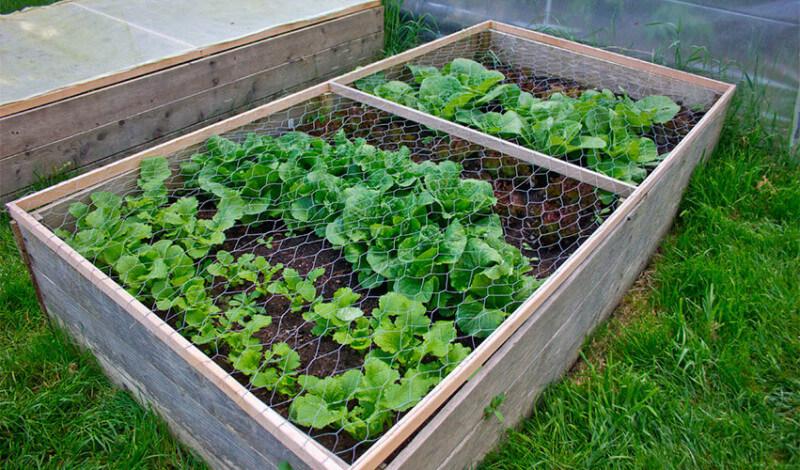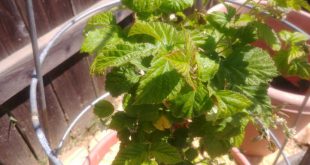Organic gardeners share a challenge that has many faces – how to protect seedlings to the point where they are strong enough to defend themselves. Because seedlings are so tender and tasty and lie deep in the ground, they are easy to harvest for a wide range of animals, from very small to huge. Everything from wireworms and millipedes to raccoons and deer likes to eat vegetables and sometimes kills an entire bed of newly emerged plants.
Every spring we receive a large number of emails with the question: “How can I protect my seedlings (insert pest here)?” The best advice we can offer is to correctly identify the pest in question and try to understand its behavior and needs. Apart from a common taste for vegetables, snails and rabbits have very little in common, which is why the strategies for combating them are also different. Let’s start with the most common garden pests and try to give sound advice.
1. Snails & snails
During the day, these gastropods have to seek protection from the sun. Snails can withdraw into the air conditioning of their shells, but snails have to seek deep shadows or total shadows. This is their greatest weakness and the basis for the best organic strategies to control them. Water first thing in the morning after sneaking into their hiding places during the day. The evening watering creates the ideal environment for snails and snails and invites you to feast. Due to the morning irrigation, the garden is relatively dry in the evening, especially in summer. Also remove ALL possible hiding places from the garden that are not absolutely necessary – unused pots, bricks, boards, plastic mulch and everything that they can hide under, especially where moisture can accumulate.
Snails can be caught by omitting small beer tubs as they will be attracted to and drown in the smell of the yeast. Even easier than this method is to intentionally leave out an obvious hiding place overnight, encourage them to gather there, and then get them off the premises the next morning. Plywood works well for this type of trap. Just leave a piece between your beds and collect the snails the next morning.
There is a lot of wisdom about different materials that snails don’t like to cross. The idea is to build a barrier around the garden, and the snails don’t dare to go over the deposited material. We experimented with crushed eggshells and were not impressed with the results. Human hair collected in a barber shop is another option that, in our experience, doesn’t work well enough and looks very strange.
2. Woodlice
These are the little gray-colored, armored guys that seem to be inexhaustibly available in coastal gardens. They are crustaceans of the Oniscidea subordination, which represents around 3,000 species. Some of them, in the genus Armadillidium, can roll into a perfect ball as a means of defense. These are commonly referred to as pill bugs, as opposed to those that cannot be rolled up and are referred to as sow bugs. Because they are crustaceans, they need water to live. The more dampers the garden is, the more numerous they will come like snails. So water in the morning and remove hiding places.
Woodlice is a good example of why the “good error / bad error” approach doesn’t work well. While they can feed on delicate seedlings (especially those that have already been damaged by snails or snails), they play a key role in breaking down organic matter in the soil. The types of foods that wood lice can feed on are inedible to many other garden organisms, but what they leave behind can be broken down by bacteria and fungi. They are the key to healthy composting systems, so removing them is a poor choice. Just try to keep the garden as dry as possible.
Okay – so the same strategies can be applied to snails, snails and wood lice. If they cannot be controlled in the garden, it may be time to use only transplanted vegetables and stop sowing directly. Established plants have an easier time dealing with pests than seedlings.
3. Specific insects
We have developed beyond the thinking of the ancient dinosaurs, which says: “Simply spray the entire area with Malathion or Diazanon and kill all insects at once.” No, it won’t work. What organic gardeners want is MORE insects, not less, and we want them to be available in sufficient numbers so that they are harmoniously balanced in our gardens and in our soil. So if you find any damage to your plants or ornamental plants, it is important to correctly identify the culprit.
If you can’t see and identify the killer insect, try to identify the damage it does to the crop. Here are some typical examples.
Small, pin-like holes appear in the middle of the leaves in mustard, lettuce and spinach – almost always flea beetles.
Sudden, dramatic damage to the leaves of brassicas (cabbage, cauliflower, broccoli, kale, kohlrabi) – almost always cabbage moth (true name Little White Butterfly).
Orange “traces” or irregular, slightly indented lines around carrot roots – almost always larvae of carrot rust flies.
Small holes directly in hard root crops such as carrots, beets or potatoes – almost always wireworm.
Entomologists categorize groups of similar insects into “orders”. The order Lepidoptera, for example, includes all moths and butterflies. Beetles are all in the order of Coleoptera; Flies, Diptera; Bees, wasps and ants, Hymenoptera; and so on. These groups not only show how insects are related, but also provide helpful guidance to gardeners who need pest control. For example, the bacteria are known as Bacillus thuringiensis (BT) can be used as a biological control for all butterflies (moths and butterflies), but does not harm other types of insects. Predatory nematodes can be used as biological controls for beetle larvae in the soil, but they do not harm earthworms or other useful soil creatures, for example.
You can find information on how to deal with certain insects in certain groups of plants in our Website article here. We would like to emphasize that the organic approach depends on correctly identifying the pest in question and then taking the appropriate measures for the one insect.
4. Mammals
The tops of the radishes were all nibbled over the bottom line? An entire bed of seedlings was “crowned” overnight? Curious poop appear, buried or otherwise? Correct identification of the guilty mammal in question also helps control, but establishing a physical barrier between the mammal and the culture is the most obvious first step. Chicken wire can be so effective in rabbits and rats that they just give up and go to greener pastures. Cats must have a more obvious barrier between themselves and their beautiful new raised beds. Try building a light frame that’s about the size of your raised bed. PVC pipe works very well for this. Then stretch any kind of durable net with small holes over the frame and leave it over your beds the entire time your seedlings appear. As soon as the planted bed is full of plants, it will no longer be attractive as a litter box and the frame can be put away for a year.

If you want to have a rabbit and deer-free area where vegetables, herbs and flowers can be grown, you just have to build a fence. It must be high enough so that deer cannot jump over it, and constructed so that rabbits cannot wiggle down. Rabbit and deer repellants work to a certain extent. They usually consist of dried deer blood and must be used regularly enough for the fresh scent to alert the deer and make them fly. But in a dry summer, when grazing is poor, deer only take food wherever they can get it, so this is not 100% reliable.
All mammals have sensitive mucous membranes. A mixture of soapy water with a small amount of cayenne pepper can be sprayed onto areas where no physical barriers are possible or if the pest in question is too small (mice, voles) to control with a conventional fence. Cayenne works because it causes temporary pain to the mammal in question, but we have mixed feelings. We prefer physical barriers and would only use cayenne pepper as a last resort.
5. Animals that are not the problem
We occasionally receive calls or emails from customers who want to get rid of perceived pests that aren’t really pests. It is often best to just leave them alone or learn to live with them.
Moles are carnivores that tunnel through the ground in search of earthworms and maggots. The only damage they can do to crops is to accidentally move roots when digging new tunnels. If there is no physical barrier that prevents them from leaving the garden, they will eventually move. So just ignore them.
Ants are not pests. It is true that carpenter ants can cause serious problems if they nest in a house, and ants can be a nuisance indoors, but in the garden, like their hymenoptera cousins, they are wasps. They remove other insects from the garden and are completely beneficial in most cases. There is a common misdiagnosis that ants carry aphids in fruit trees to “breed” them by collecting honey from the aphids. While ants certainly harvest honeydew from aphids, they do not carry the aphids into the tree. If you “saw how they did it”, please take a closer look. The ants are on the tree because there are aphids. The aphids are on the tree because the tree is under some kind of stress nine times out of ten. Instead of focusing on the ants, focus on the health of the tree – apply lime and plenty of water and apply fertilizer. Maybe cut grass back from the base of the tree. Treat the aphids with water jets from a hose or apply safer soap. Don’t worry about Tanglefoot or Vaseline. These treatments only make your tree sticky and are not effective against aphids or useful ants.
Spittlebugs are not pests either. These are the tiny yellow or green guys that appear on the stems of flowering plants in late spring – they’re pretty noticeable on lavender stems. While it is true that they suck plant juices just like aphids, they will only be there for a few weeks. This is because they are the nymph stage of the adult insect known as the Froghopper (order Hemiptera). Froghoppers and their close cousins Leafhoppers are the very small, hard-shelled creatures that suddenly end up on your shirt when you are outside in the garden. As soon as they are touched, they jump off with incredible power and you will not see them again. If there are nesting bugs, try looking away and continuing to weed.
Finally, we find it most helpful to choose a non-controversial approach to gardening. By maintaining healthy soils and ecologically diverse gardens, we can produce healthier plants with better resistance to pests and diseases. We can attract predatory wasps, ladybugs and other useful insects by inviting them into the garden with the appropriate selection of plants. Grow Dill! Plant alyssum. Let last year’s parsley bloom and go to seed. Keep the acreage clean but varied. Our friend and colleague Brian Campbell recommends dedicating an area of the garden where you will never set foot. Leave it aside to act as an undisturbed natural environment in which nature can really take its course.
For further reading I recommend two books: The organic gardener’s guide to combating natural pests and diseases by Bradley, Ellis and Martin is an excellent reference work for the identification and control of insect pests and for the prevention of plant diseases.




